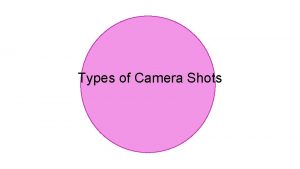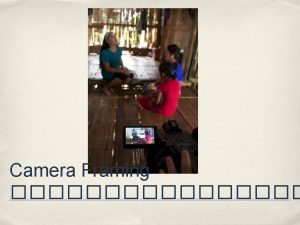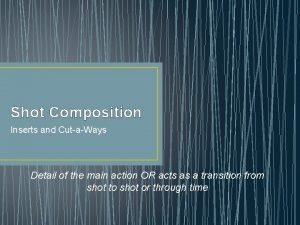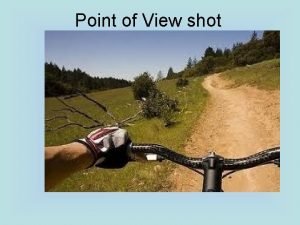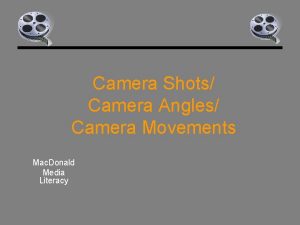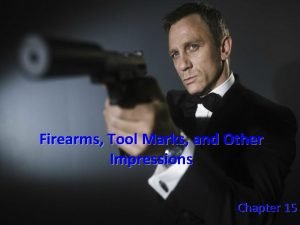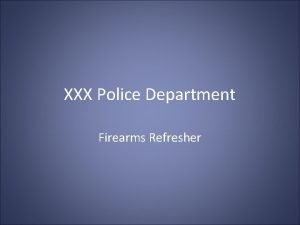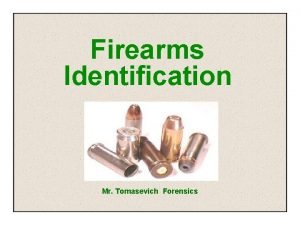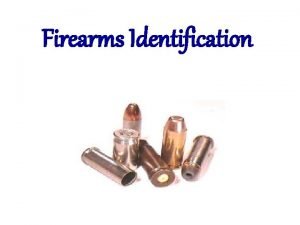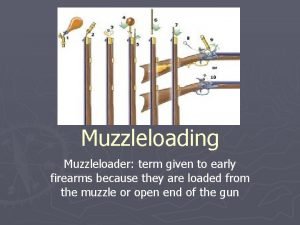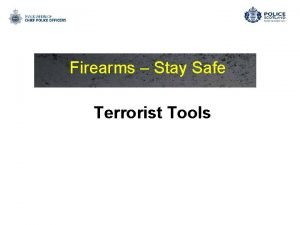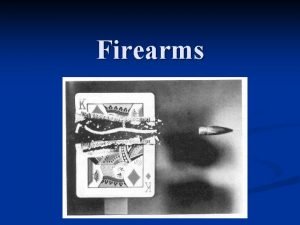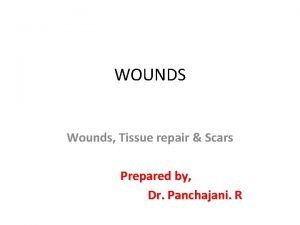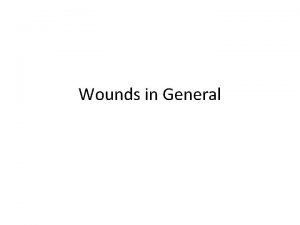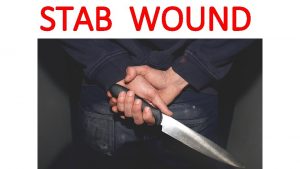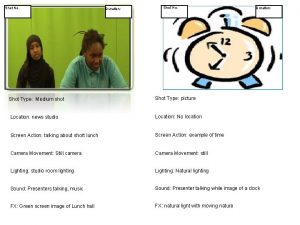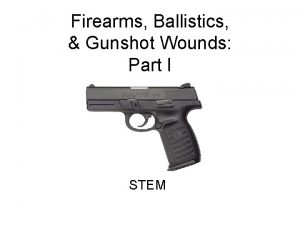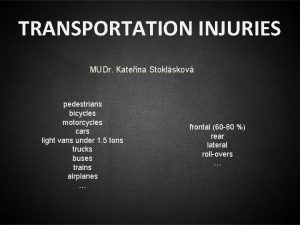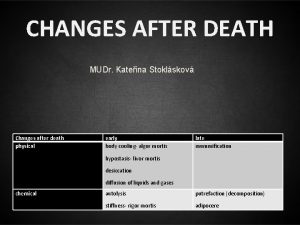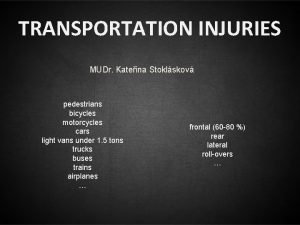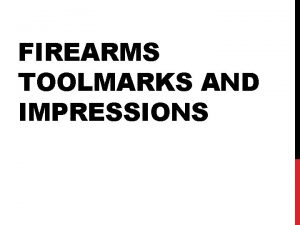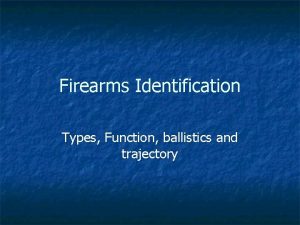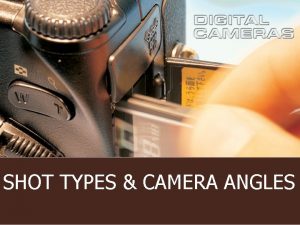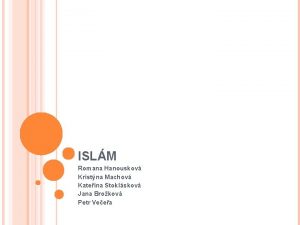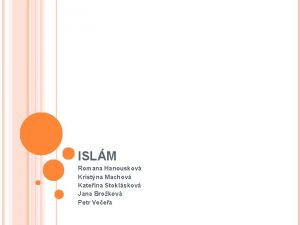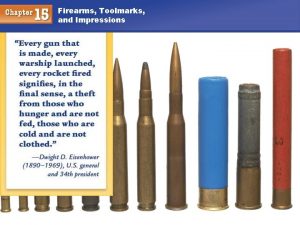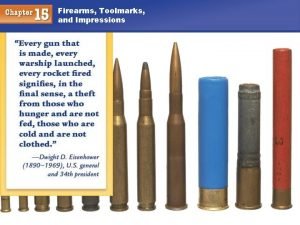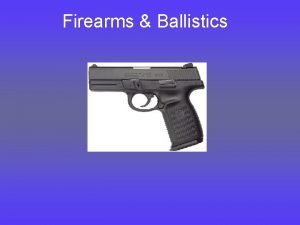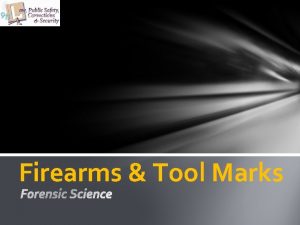Shot wounds MUDr Kateina Stoklskov Types of firearms

























- Slides: 25

Shot wounds MUDr. Kateřina Stoklásková

Types of firearms: • according to the length of the gun-barrel short - for handling by one hand, length of the barrel doesnt exceed 30 cm (total length doesnt exceed 60 cm)- pistol, revolver long - for handling by both of hands

Types of firearms: • according to the type of the projectile: – rifled weapons – handguns – revolver – has a rotating cylinder carrying a variable number of shells – „automatic“ pistol – self-loading, has its shells in a spring-loaded magazine – rifles – self-loading or truly automatic – shotguns muzzle velocity up to: revolver 150 m/s pistol 360 m/s rifle 1500 m/s

Rifled weapons- revolver Revolvers have a revolving cylinder that contains several chambers (5 -8), each of which holds one cartridge. The revolver is the most common type of handgun in the United States. The first revolver was produced by Samuel Colt in 1835– 1836.

Rifled weapons • • • long or short fire one projectile at a time barrel has spiral grooves machined on its inner surface

Rifling bore 1. gun caliber 2. spiral grooves (4 -8) 3. lands • the elevations between the grooves are the „lands“, which grip the bullet as it passes down the barrel and give it a rotatory movement Commonly used calibers: pistols: 6, 5 mm, 7, 65 mm, 9 mm, . 22, . 40, . 45 revolvers: . 36, . 38, . 357

The ammunition for rifled weapons 1. Single projectile doesn´t split after leaving the muzzle 2. Cartridge case- made from lead, holds the cartridge together 3. Propellant- today smokeless powder- nitrocellulosis- while burning produces expanding gases (CO, CO 2, H 2 O, H, N) 4. Flash hole- connects primer and the cavity of cartridge case 5. Primer- initiates burning of the propellant

Single projectile Fully covered by hard metal jacket- lead core and steel jacket with Ni, Zn, Cu Semi- covered- soft- tipped, used for hunting, increased wounding potential „Hollow point“ projectile- has air space in the tip designed to distort the bullet on impact

Projectile doesn´t enter the body • low energy projectile- usually ricochet bullet • haematoma or excoriation, contusion

projectile touches the body surface and leaves a groove In a tangential wound, a bullet strikes the skin producing an elongated wound that extends down through to the subcutaneous tissue.

Projectile enters the body and stays in

Projectile enters and exits the body exit wound track entrance wound

Entrance wound- contact wounds • In contact wounds, the muzzle of the weapon is held against the surface of the body at the time of discharge. • When a weapon is fired, the gases produced by the combustion of the propellant emerge from the barrel in a highly compressed state. In hard contact wounds, they follow the bullet through the skin into the subcutaneous tissue where they • immediately begin to expand. The ballooned-out skin may slam against the muzzle of the weapon with enough force to imprint the outline of the muzzle on the skin.

Contact wounds- smoke cavity • The gases produced by the combustion of the propellant emerge from the barrel and follow the bullet through the skin into the subcutaneous tissue where they immediately begin to expand. In hard contact wounds large quantities of black amorphous material, predominantly soot, and the powder grains are found in the smoke cavity and the wound track. • In contact gunshot wounds the gas expanding in the subcutaneous tissue causes tearing of the skin- in regions of the body where only a thin layer of skin and subcutaneous tissue overlies bone usually have a stellate or cruciform appearance that is totally unlike the round or oval perforating wounds seen in other areas. • One of the most prevalent products of burning is carbon monoxideenters the tissues and causes bright red color around entrance wound.

Entrance wound- intermediate-range • An intermediate-range gunshot wound is one in which the muzzle of the weapon is held away from the body at the time of discharge yet is sufficiently close so that powder grains expelled from the muzzle along with the bullet produce “powder tattooing” of the skin. • For handguns, powder tattooing begins at a muzzle-to-target distance of approximately 10 mm. • In addition to the powder tattooing, there may be blackening of the skin or material around the entrance site from soot produced by combustion of the propellant. • For virtually all handgun cartridges, soot is absent beyond 30 cm. • Most entrance wounds, no matter the range, are surrounded by a reddish, reddish-brown zone of abraded skin — the abrasion ring. This is a rim of flattened, abraded epidermis, surrounding the entrance hole. • Minus effect of tissue- due to tightening and the skin spray effect.

Entrance wounds- distant wounds • In distant wounds, the only marks on the target are those produced by the mechanical action of the bullet in perforating the skin.

Flat bones: The entrance has a round to oval, sharp-edged, “punched-out” appearance. The opposite surface of the bone, i. e. , the exit side, is excavated in a cone-like manner.

Wound track The canal in the body is in the first time temporary, 3 -4 times pulsing (lasting a few hundredths of second). It is followed by a permanent canal visible by a view. 1. temporary canal 2. permanent canal 3. tissue contusion

Exit wounds • Exit wounds, whether they are the result of contact, intermediate, or distant firing, all have the same general characteristics. • They are typically larger and more irregular than entrance wounds and, with rare exception, do not possess an abrasion ring. • Exit wounds can be stellate, slit-like, crescent, circular, or completely irregular.

Shotguns • long barrel- 45 -90 cm, is intended to be fired from the shoulder • it has a smooth bore and is designed to fire multiple pellets from the barrel- so called shots • there also special single projectiles for shotguns • often have two barrels- side-by-side or up-and-over (can have from 1 up to 4 barrels) • semi-automatic or repeating (pump-action)

Sawed off shotgun- has illegaly shortened barrel • increases divergency of shot bolus in shorter distance • easier to hide

The ammunition for shotguns • Multiple projectile • cardboard or plastic tube, metal base, central detonatig cap • propellant charge capped by wad • mass of lead shots- usually 3 -4 mm in diameter

• After leaving the muzzle, the bolus of shot begins to diverge, so that the shot pattern is a long shallow cone. • The further along this cone this victim is situated, the larger will be the wound pattern.

Explosive injuries • Warfare, terrorism • Accidents (gas explosions, …) • Blast syndrome

References: Knight´s Forensic Pathology, 2004
 Mid shot example
Mid shot example Extreme medium shot
Extreme medium shot Ews camera shot
Ews camera shot Cut away shot example
Cut away shot example What is subjective pov
What is subjective pov Shot to shot analyse eksempel
Shot to shot analyse eksempel Wide shot medium shot close up
Wide shot medium shot close up Name of camera shots
Name of camera shots Slide drag mark
Slide drag mark Chapter 15 firearms toolmarks and impressions
Chapter 15 firearms toolmarks and impressions Mptc firearms instructor manual
Mptc firearms instructor manual Firearms
Firearms Virginia state police firearms transaction center
Virginia state police firearms transaction center Firearms
Firearms Firearms
Firearms Bullet identification
Bullet identification Firearms
Firearms Waryas foxboro
Waryas foxboro Firearms
Firearms Drugfire
Drugfire Afte theory of identification
Afte theory of identification Cdc firearms
Cdc firearms Wound type
Wound type Kinds of wounds with pictures
Kinds of wounds with pictures Unit 15:6 providing first aid for burns
Unit 15:6 providing first aid for burns Wedge shaped wound
Wedge shaped wound
